Content
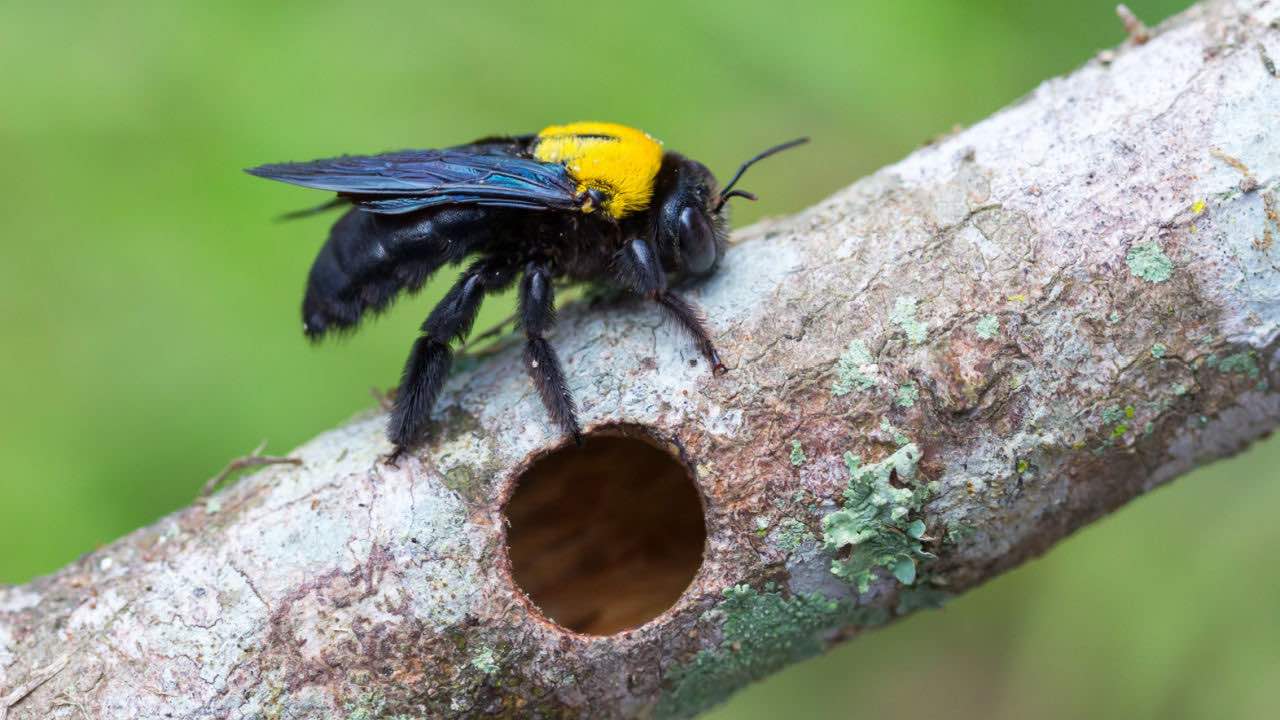
The carpenter bee is a species of bee belonging to the genus Xylocopa. These adorable creatures are known for their remarkable woodworking abilities. Unlike honeybees and bumblebees, which nest in hives or underground, carpenter bees build their nests by tunneling through wood. They prefer dead or rotting wood, such as old tree trunks or untreated wooden structures.
Now you may be wondering why we should value carpenter bees in our gardens. Well, they are exceptional pollinators!
These bees play a crucial role in the ecosystem by visiting a wide variety of flowering plants. As they move from flower to flower in search of nectar and pollen, they transfer pollen grains, enabling the plants to produce fruits and seeds. By supporting the pollination process, carpenter bees contribute to the overall health and productivity of our gardens.
You might have concerns about the potential damage carpenter bees can cause to wooden structures. However, it's important to note that they typically target untreated or weathered wood. In a sustainable and organic garden, we can take steps to prevent or minimize damage while still appreciating these remarkable creatures.
By providing alternative nesting options, such as bee houses or bee hotels made from untreated hardwood logs or wood blocks, we can lure carpenter bees away from our wood structures and provide them with suitable habitats.
It's also worth mentioning that carpenter bees are generally harmless and rarely stinging. The males, who often hover around their nesting sites, are territorial but lack a stinger. The females do possess stingers, but they are docile and only sting when provoked or threatened. So, there is no need to fear them while working in your garden.
By understanding and respecting the role of carpenter bees in the ecosystem, we can promote a harmonious relationship with these hard-working pollinators.
Through sustainable gardening practices that prioritize plant diversity, organic pest control and providing alternative nesting options, we can create a garden that thrives with the presence of carpenter bees while maintaining the integrity of our timber structures.
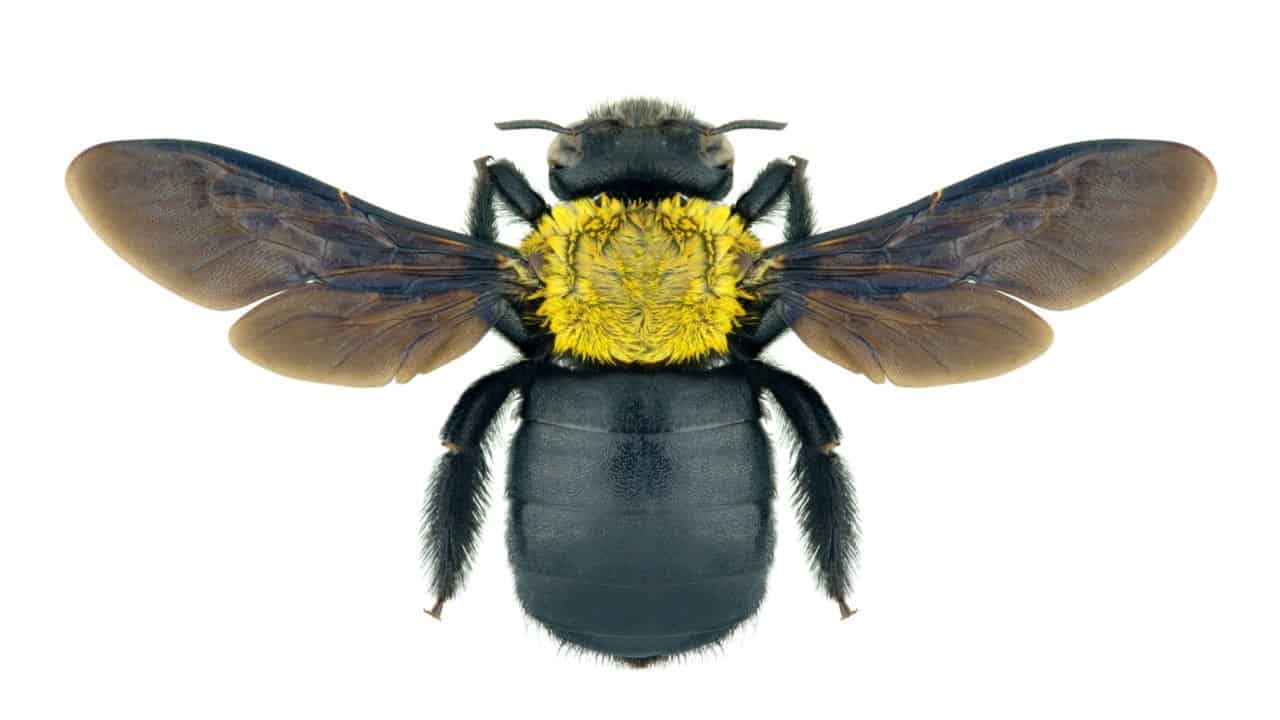
What is a carpenter bee?
The term carpenter bees apply to several different bees in the US that excavate tunnels in sound wood. Carpenter bees have a similar appearance to bumble bees, but the top surface of the abdomen is black, shiny, and almost entirely hairless. Females have a black face, while males' face is white.
These bees get their common name from the habit of female carpenter bees to dig nesting galleries in the forest for their young. Carpenter bees are important pollinators, feeding on nectar and pollen; they don't eat wood.
Larger carpenter bees belong to the genus Xylocapa. Two native species, Xylocopa micans and Xylocopa virginica, are found in the eastern United States. A few native carpenter bees are also found in the western United States.
Carpenter bees can often be seen hovering near eaves, decks, and porch roofs. It is important to be careful when carpenter bees are roaming around you, as male bees work as "patrol" bees and can be aggressive when defending their territory; the good news is that their aggression is just a show as they cannot sting. Female carpenter bees are not aggressive and do not usually defend nesting sites, although they may sting if handled.
Carpenter bees, while relatively harmless, increase the number of nests with time, causing significant damage to wood. They can also leave marks with their faces.
People are usually alarmed when they see carpenter bees crawling out of a tree. Females can sting, but only if provoked. The males are hostile, flying around people and pets, but they are not dangerous because the males do not have a stinger.
Although these pests can cause damage to wood, homeowners can do a few simple things to keep them under control, such as painting the wood and keeping exterior doors locked to limit carpenter bees' access to wood that can be used for gallery building.

Life cycle of a carpenter bee
Adult bees overwinter in wooden tunnels and emerge the following spring to mate. Having freed up new space for eggs in existing burrows, female bees fill the chambers with beebread, lay one egg at a time, and seal each chamber.
Typically, eastern bees produce 6-8 eggs at a time. The bee spends an average of two days as an egg, 15 days as larvae, four days in the prepupal stage, and fifteen days as a pupa.
The adults emerge in August, feed, and then return to the same nest to overwinter and begin the process. In general, carpenter bees (and bees in general) can live up to three years.
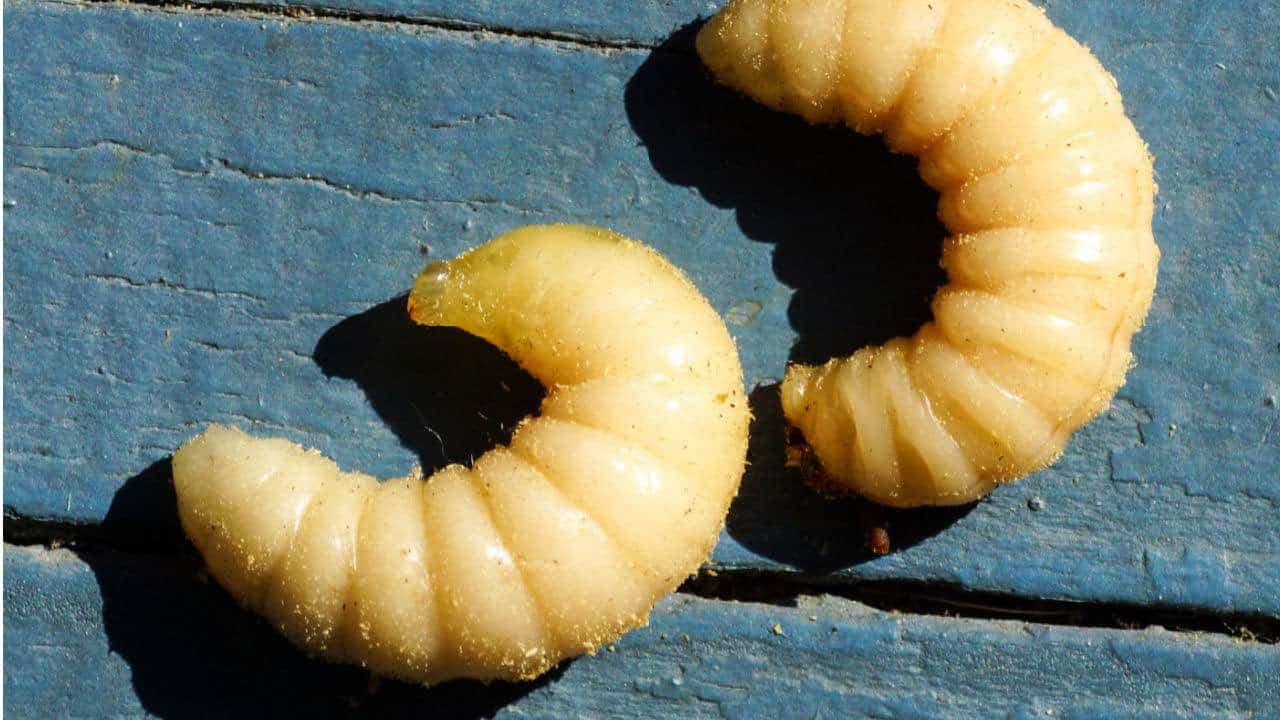
Are Carpenter Bees Dangerous?
Carpenter bees are generally harmless, although their presence near the entrance to a home or building can be a concern. Female carpenter bees rarely sting unless they feel directly provoked, and their stinger is not barbed like that of a honey bee or bumblebee.
The only real danger posed by carpenter bees is the potential damage to wood structures if they decide to make their nest inside. Their boreholes have the potential to weaken beams and posts, and their presence near buildings can lead to further damage if not taken care of.
How to Identify a Carpenter Bee
These bee species are robust and can measure up to 1 inch long. The upper surface of their abdomens is mainly bare and appears shiny black. The thorax is covered in orange, yellow, or white hair. Their head is almost as broad as their thorax. These bees have a dense quantity of hairs on their hind legs.
Resembling bumblebees, carpenter bees have the same size except for their head, with the bumblebee's head being much narrower than the thorax. Bumblebees have very hairy abdomens with yellow markings and large pollen baskets on their hind legs. As social insects, bumblebees live in colonies with nests typically in the ground.
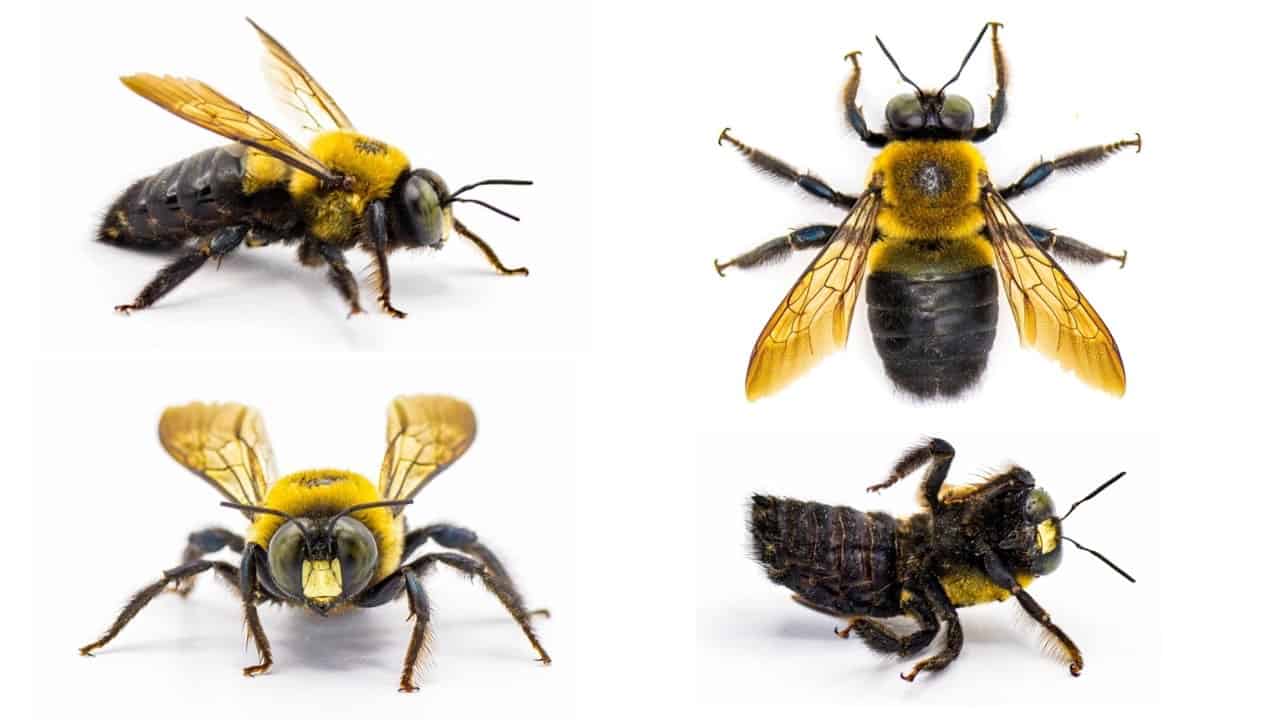
Where are carpenter bees found?
As solitary insects, carpenter bees do not build colonies. Each female bee creates its nest gallery inside of a wood surface. Several carpenter bees often use the same piece of wood, with galleries happening close to each other, but each bee behaves independently of other members.
Male and female bees emerge in April throughout the spring and mate. Territorial males circle nearby when mating females begin nesting activity.
Construction of a gallery is an energy-intensive and labor-intensive process; Women carpenters prefer to repair an old nest rather than create a new one. Female carpenter bees may use an existing galley, extend it, or dig a new gallery from an existing entry hole.
To create a new nest, female carpenter bees use their strong mandibles to dig a round, clean entrance hole just under ½ inch wide, which is approximately the diameter of their body.
She then drills into the wood perpendicular to the grain, rotates and excavates along the grain of the wood about 4 to 6 inches to create a gallery (tunnel). She excavates it at a rate of about 1 inch in six days.
Each carpenter bee creates a row of brood cells inside the gallery. The larval reserve consists of a mixture of pollen and regurgitated nectar balls. The females form a food bolus at the far end of the excavated gallery, lay eggs on top of the mass, and then separate the walls of the brood cell with chewed wood mass.
Female carpenter bees often create six to ten divided brood cells linearly in a single gallery and then die shortly thereafter. Male carpenter bees are also short-lived. The larvae feed on a food mass of nectar/pollen, which is sufficient for them to develop to the pupal and adult stages.
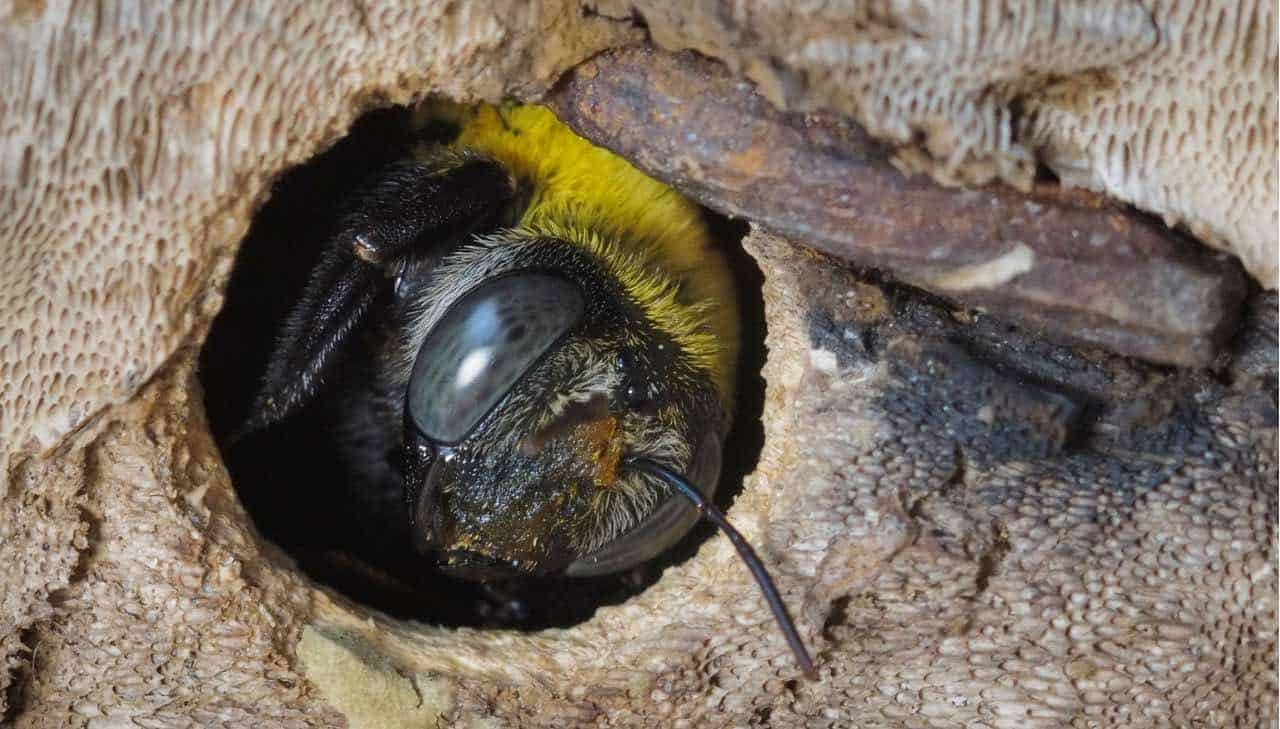
Do carpenter bees sting?
If you see a carpenter bee darting and buzzing aggressively towards you, it is probably a male bee. Male carpenter bees do not have a stinge, so they'll put on a threatening display as a defense mechanism.
On the other hand, female carpenter bees have a stinger containing venom and, unlike other flying insects, they are capable of stinging more than once. Female bees tend to stay close to their eggs, so you're unlikely to run into them unless you disturb their nest; they will only sting if they sense direct provocation.
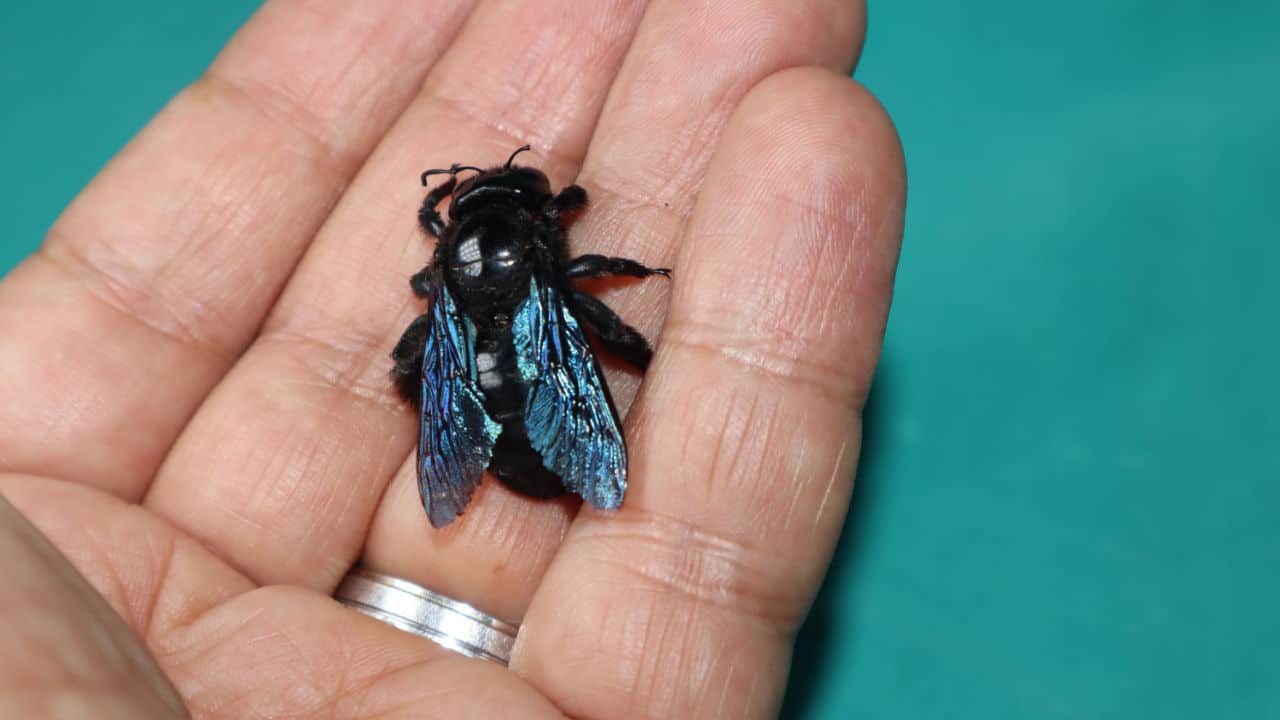
Damage caused by carpenter bees
Carpenter bees can damage wooden structures, including decks, eaves, fences, and wood furniture. They are considered a serious property nuisance and are even treated because they can cause structural damage if left untreated.
They create tunnels by drilling into untreated or weathered wood, usually targeting softwoods such as cedar, redwood or pine. The entrance holes they create are usually circular and about half an inch in diameter.
While the damage caused by carpenter bees can be unsightly, it is important to note that they usually pose minimal risk to the structural integrity of wood members.
Unlike termites, carpenter bees do not use wood as their primary food source. Their passages are mainly used for nesting and do not go deep into the forest.
Over time, weathering and exposure to the elements can cause untreated wood to develop cracks, which can make it more susceptible to carpenter bee activity. However, regular maintenance and sealing of wooden structures can help minimize the potential damage caused by carpenter bees.
Although carpenter bees' direct damage to wood is typically limited, their activities can attract woodpeckers and other secondary pests. The large larvae developing into tunnels in homes are often attractive to woodpeckers who seek out developing carpenter bees and expand damage to existing holes.
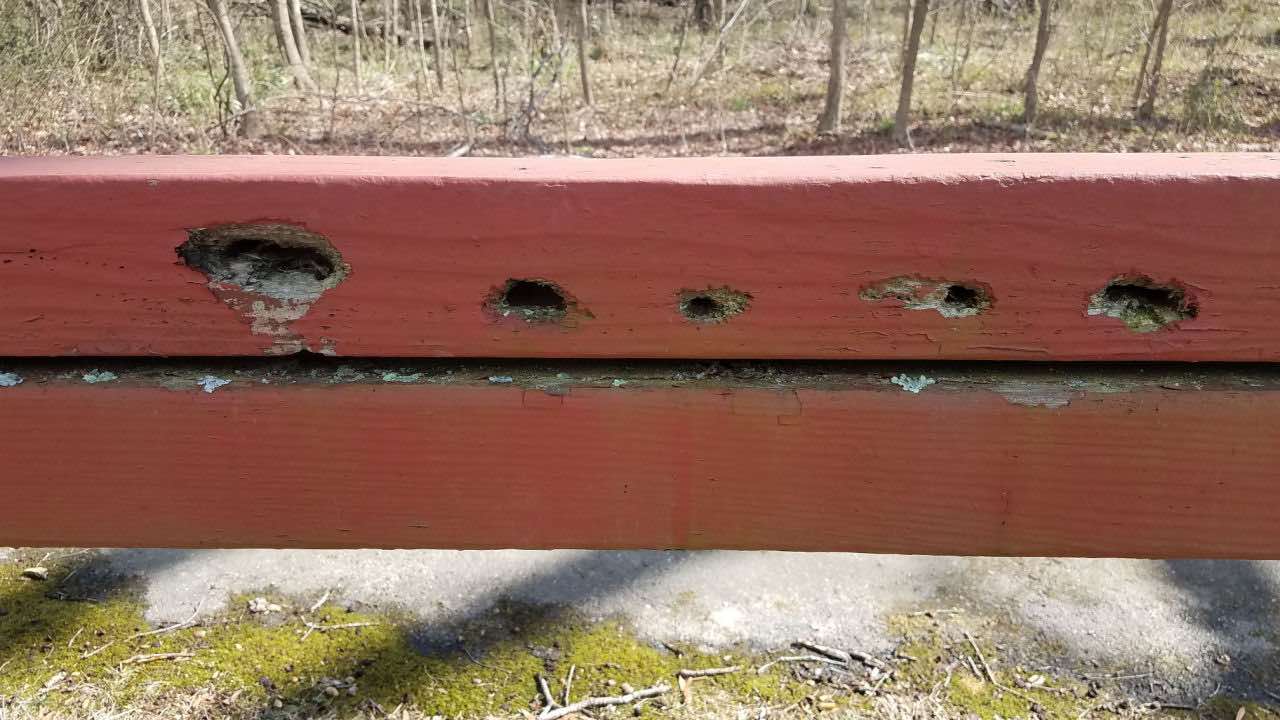
Signs of a carpenter bee infestation
Carpenter bees make distinct, circular entry holes in wood, usually about a half-inch in diameter. These holes are smooth and can appear as perfectly drilled circles on the surface of wood structures. Keep an eye on these entry holes, especially in untreated or distressed wood.
As carpenter bees tunnel into wood, they push out the wood particles or frass. This results in the accumulation of sawdust-like material below the entry holes. You may notice small piles of sawdust or frass near the holes, indicating carpenter bee activity.
Another sign of carpenter bee infestation is the presence of bees near wooden structures. Male carpenter bees, which are often more noticeable due to their territorial behavior, may hover around nesting sites or fly in a distinct zigzag pattern. Female bees may be seen entering or exiting the entry holes.
Woodpeckers are natural predators of carpenter bees. If you notice increased woodpecker activity, such as pecking or drilling holes in wooden structures, it could be an indication of carpenter bee infestation. Woodpeckers are attracted to the carpenter bee larvae and seek them out as a food source.
Over time, the constant activity of carpenter bees can cause visible damage to wood structures. Look for signs of wood deterioration, such as soft or weakened areas, splitting or crumbling of wood around entry holes.
However, it is important to remember that carpenter bee damage is usually limited to the surface layers of wood and does not usually affect structural integrity.
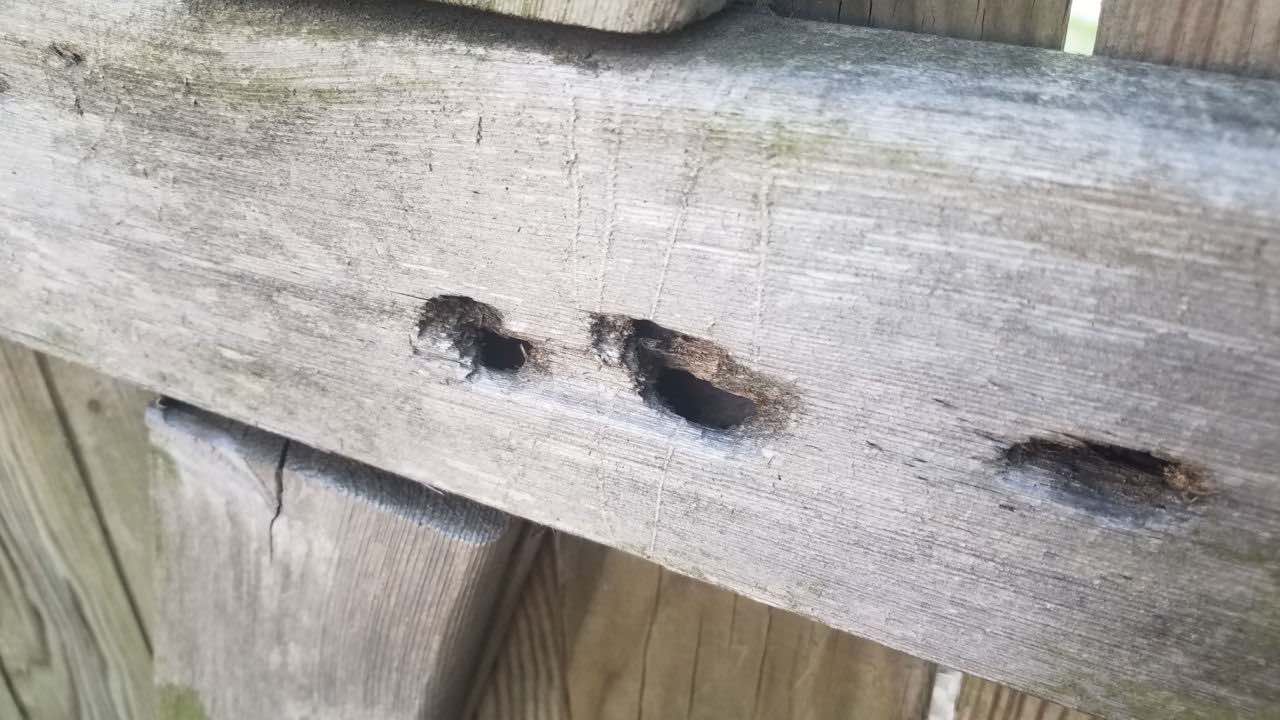
How to Get Rid of Carpenter Bees
Provide alternative nesting sites
Since carpenter bees are attracted to untreated or weathered wood, you can discourage them from attacking your structures by offering alternative nesting options.
Install bee blocks or bee hotels using untreated hardwood logs or wood blocks with pre-drilled holes. They will provide a suitable home for carpenter bees, diverting their attention from wooden structures.

Use traps
Carpenter bee traps are simple and effective devices used to catch and control carpenter bees. Traps are usually made from pre-drilled wooden blocks attached to glass jars or plastic bottles. The bees are attracted to the wooden block that mimics their natural nesting environment and crawl into the pre-drilled holes. Once trapped, the bees cannot escape and eventually die. Carpenter bee traps are easy to make at home, and there are many commercially available options.
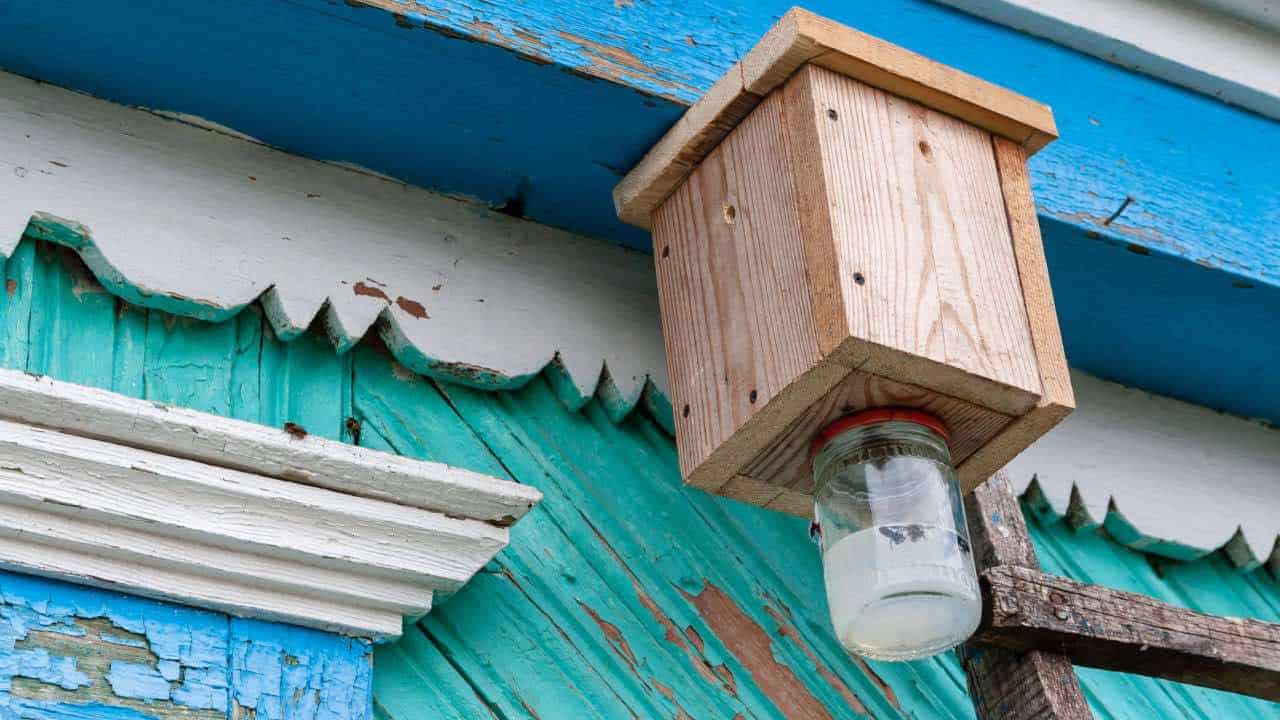
Fill existing bee holes
If you identified have carpenter bee holes in your wooden structures, you can fill them with wood putty or caulk during the late fall or winter when the bees are not active.
Alternatively, you can cover the entry hole with a wooden dowel coated with wood glue. This will keep future bees from using old tunnels, rotting wood, and getting moisture in. Be sure to repaint or seal the repaired areas to prevent future infestations.
Paint or seal woodwork
The best time to attack carpenter bees is before their tunnels are fully built.
To make your wooden structures less appealing to carpenter bees, consider painting or sealing them. Bees are less likely to target surfaces that are smooth, painted, or coated with varnish or polyurethane. Opt for eco-friendly, low-toxicity paints or sealants to maintain organic practices.
Stains and preservatives are less durable than painting, but can provide some repellency compared to bare wood. It also helps keep garages and outbuildings closed when bees are active.
Use natural repellents
Certain scents and oils can deter carpenter bees. Applying natural repellents like citrus oil, almond oil, or eucalyptus oil to wooden surfaces may discourage bees from nesting. However, keep in mind that these repellents are temporary and need to be reapplied periodically.
Promoting plant diversity
Encouraging a diverse range of flowering plants in your garden attracts a variety of pollinators, including carpenter bees.
By providing abundant sources of nectar and pollen, you can create a balanced ecosystem in which carpenter bees are less likely to concentrate on a particular area. Native flowering plants are especially beneficial because they have co-evolved with native pollinators.
Encourage Natural Predators
Introducing natural predators can help control carpenter bee populations, as some wasp species are known to prey on carpenter bees.
Providing suitable habitats such as trees, shrubs and wild areas can attract these natural predators to your garden.
Monitoring and manual removal
Check wooden structures regularly for carpenter bee activity. If you notice holes or bees, you can physically remove them using a vacuum cleaner or a jar with a lid. Be sure to release them away from your property to prevent re-infestation.
Plant Repellent Herbs
Some aromatic herbs, such as mint, rosemary and thyme, have natural repellent properties that can repel carpenter bees. Plant these herbs near wooden structures to create a barrier and discourage nesting.
WD40
One of the most common ways to get rid of carpenter bees is to use WD40, which is an alternative to the insecticides used by old-time farmers.
These petroleum-derived products effectively kill all insects. To spray into tunnels, use a sprayer with an extension tube.
Insekticidы
As a last resort, some insecticides can be used. Aerosol, liquid or dust insecticides can be applied directly to tunnel openings.
After treatment, leave the holes open for a couple of days to allow flying insects to make contact and distribute the insecticide throughout the tunnel.
Other pest control guides from BezTarakanov:
How to effectively get rid of wasps and prevent new nests from appearing
The Great Black Wasp - Everything You Need to Know in 2023
Previous